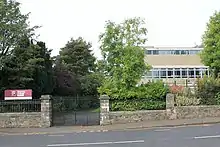Victoria College, Belfast
Victoria College, Belfast is a voluntary non-denominational Independent grammar school in Cranmore Park, Belfast, Northern Ireland. In 2007, the college had 867 pupils aged 11 – 18 and a Preparatory Department with 175 students, aged 3 – 11.
| Victoria College, Belfast | |
|---|---|
 | |
| Location | |

| |
Cranmore Park | |
| Coordinates | 54.573°N 5.949°W |
| Information | |
| Type | Voluntary independent grammar school |
| Motto | Honor Fidelitatis Praemium (Honour is the reward of loyalty) |
| Established | 1859 |
| Founder | Margaret Byers |
| Sister school | Royal Belfast Academical Institution Rugby School |
| Principal | Mrs Lanky Quinn |
| Age | 3 to 19 |
| Number of students | 175 aged 3-10 867 aged 11-19 |
| Houses | Cresent Pakinham Wellington Marlborough Richmond coward |
| Website | www |
Victoria College has been awarded specialist school status beginning from September 2009.[1] The college will specialise in STEM-related areas (Science, Technology, Engineering and Maths).
History
Founded by Mrs Margaret Byers (1832–1912) in 1859,[2] it is one of the longest established girls' schools in the British Isles. The college was established in Wellington Place and was first known as The Ladies' Collegiate School Belfast.
In 1888, Queen Victoria's Jubilee Year, the name of the school was changed by Royal Command to Victoria College and School. A century later, Victoria College amalgamated with Richmond Lodge School, a neighbouring girls' school of similar status.
The origins of Richmond Lodge lie in a school opened in 1889 by the Misses Hardy on the Stranmillis Road. It moved to the Malone Road in 1913 and soon acquired full academic recognition. Richmond Lodge past pupils continue their association with the school through the Arellian Association.
From 1947 to 1970, the art department at Victoria College was headed by Mercy Hunter, a notable calligrapher and influential teacher.
Over the past 150 years, Victoria College (as it is now called) has relocated four times. Former Belfast locations include Howard Street, Pakenham Place and Lower Crescent before the current school was established at Cranmore in the 1970s. School house names reflect the past locations.
Location
The school has two campuses the Richmond Campus (for Forms 1 & 2) and the Cranmore Campus (for Forms 3-U6). In addition, a kindergarten for boys and girls is located within the Richmond Campus and the girls only Preparatory Department is located on the Cranmore Campus.
The whole school is situated within extensive mature grounds in South Belfast. This location between two of the main arterial routes into the city is convenient to city, town and country bus routes and the local railway network. It is also within walking distance of the Queen's University Belfast and the Ulster Museum and many local art galleries and theatres.
Staff
The school is staffed by 82 full- and part-time teachers and 30 support staff.
Boarding
Drumglass House was built in 1820 and serves as the Boarding Department for girls of all ages and all backgrounds. It is located within the grounds of the Cranmore Campus. The Boarding Department caters for up to 60 boarders, many from Europe or East Asia.[3]
150th anniversary
2009 saw the 150th anniversary of the founding of the college. Throughout 2009, events celebrating the history of the school took place. An exhibition opened in May 2009 at the college.
In addition, the college has been successful in several competitions. These include
F1 in Schools 2009 - National champions, GT class.
UKAYRoC 2009 - Only all-girls team to finish in the top three.
STEM related achievements
In 2010, a team of pupils from the College won their regional heat of the Faraday Challenge[4] and subsequently took first prize at the National Finals held in Manchester.
Exam results
GCSE and A-level results in the college are consistently high every year. The exam boards offered to students are Edexcel, AQA, OCR, CCEA, WJEC. The % pass rate at grades A* to C (exams at age 16 - GCSE or equivalent) is 97%; the % pass rate (exams at age 18 - 'A' Level or equivalent) is 100%.
Uniform
Winter uniform
- Grey blazer
- Regulation knitted scarf (1st & 2nd Forms)
- Optional fleece scarf (3-U6th Forms)
- Maroon skirt.
- White shirt.
- School tie.
- Regulation grey pullover - available in either wool or courtelle with stripes at V-neck.
- Regulation grey cardigan, striped at edges - Sixth Form only
- Grey knee-length socks or tights.
- Plain black, flat, laced, shoes.
Summer uniform
- Grey blazer.
- A regulation grey and blue striped dress to be worn May, June and September. (Prep)
- A regulation white and maroon striped open necked shirt to be worn May, June and September. (1st & 2nd Forms)
- A regulation white open necked shirt to be worn May, June and September. (3rd-U6th Forms)
- Regulation grey pullover.
- Plain grey knee length socks or grey tights.
- Plain shoes, slight heel (laces or straps)
References
- "22 April 2009 - Specialist Schools funding announced | Northern Ireland Executive". Northernireland.gov.uk. 2009-04-22. Retrieved 2015-04-24.
- "Byers, Mrs. Margaret". Who's Who. Vol. 59. 1907. pp. 268–269.
- "Victoria College Belfast". Victoriacollege.org.uk. Retrieved 2015-04-24.
- http://faraday.theiet.org/urbanevolution/challenge/
External links
| Wikimedia Commons has media related to Victoria College, Belfast. |